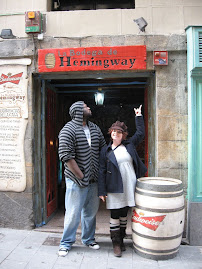"Chapter 3: Psychiatric Niche Conditions"
"Efforts to identify, categorize, and systematize differences were particular [sic] significant within the European enlightenment movement, which sough during the seventeenth and eighteenth centuries to forge clear distinctions between reason and unreason" (Nadesan 30).
"mental 'illness' was qualitatively distinguished from mental 'retardation' in the mid-nineteenth century" (Nadesan 30).
"Nineteenth-century innovations in psychiatric thought were indebted to new social and economic conditions that led to increased social surveillance and control over populations. The nineteenth century engendered new strategies for monitoring, dividing, and acting upon populations in order to foster and ensure social stability in a time of rapid urbanization and industrialization" (Nadesan 31).
"private life became subject to governmental and professional scrutiny, particularly in the extension of surveillance over populations regarded as 'deviant' and in the extension of surveillance over a person's earliest childhood years" (Nadesan 31).
"many people who are today judged as having a developmental disorder would not have been judged so before the nineteenth century and few distinctions were made between the mad and the 'feebleminded'" (Nadesan 32)
"It was not until well into the nineteenth century that 'consciousness' became a criterion used to distinguish among forms of mental illness, particularly between temporary, illness-induced delirium and pervasive insanity and that the study of psychosis was distinguished from the study of neurosis," [...] "insanity was distinguished from epilepsy, and that mental retardation was distinguished from insanity" (Nadesan 33).
Nadesan discusses the historical events that led up to the systematic efforts to identify and describe forms of psychopathology. "Enabling advances such as these were a number of historical circumstances, including the enlightenment ethos of scientific thinking and the transformation of institutions designed to house the 'insane'" (Nadesan 33). For my earlier note about the 1960's to the present, there seems to be a lack of ethos surrounding technology, medical advancements, and the government (mercury poisoning, environmental toxins, government corruption).
"madness came to be seen as the primary threat to social welfare" (Nadesan 34)--today, developmental/cognitive deficiencies/delays seem to be the threat to fear. Cultural fear of being incapacitated. Terri Schiavo as an example of this fear...
"'Governmental' power focuses both on the administration of populations and their behavioral normalization. This extension of the finality of state control to include influence over everyday affairs constitutes an important shift that [Foucault in "Governmentality" in The Foucault Effect] termed the shift from 'sovereignty' (over a territory) to 'government,' which is concerned with the disposition of things such as people, customs, habits, etc" (Nadesan 35).
"The psychiatric taxonomies [...] coupled with the transformed madhouse--the asylum--together illustrate how new forms of knowledge were concomitant with the reorganization of social space so as to divide, sequester, and administer populations" (Nadesan 35). I'm reminded here of Simi Linton's discussion on special education and the division of "normal" (nondisabled) and "special" (disabled) children in school.
"Social welfare, and the welfare of the species, demanded intensification of efforts to identify and sequester the mad and feebleminded. Thus, fearing the reproductive capacities of such 'degenerates,' the asylum took on more social import due to its ability to sequester and 'organically' mad, even while its therapeutic aspects were regarded as suspect" (Nadesan 36). I'm reminded here of my research into 19th century abortion legislation--enacted to keep the upper classes from aborting their fetuses and limiting the potential linage of moral, upstanding citizens.
"one key nineteenth-century innovation in psychopathology involved distinguishing those forms of mental illness that involved delirium and hallucinations from those that did not" (Nadesan 37).
"As interest in these disorders grew, psychiatry devised ever more strategies for distinguishing disorders characterized by 'psychosis' from more subtle abnormalities of affect, social relations, and subjective experience" (Nadesan 37).
"Bleur believed that the (schizophrenic) autistic break with reality, coupled with the other disassociations of affect and thought, ultimately leads to dissolution of personality. Personality was, in Bleur's time, understood in relation to self-awareness and subjective experience (Berrios 1996) so schizophrenia constituted a fundamental threat to the self" (Nadesan 40).
"Ernst Kretschmer, for example, distinguished between autism in which patients suppress external stimuli in order to pursue a dream existence and autism characterized by lack of emotion and affective responses to the environment" (Nadesan 40).
"autism" as a term was used often during early 20th century (Nadesan 40).
Importance of Freud to enable autism to be "psychologized" (Nadesan 42). Importance for "refrigerator mother" of 1960's: Freud's work had the "implication of bringing into focus the inner psychic life of childhood, a state whose complexities and crises demanded careful parental care guided by professional expertise" (Nadesan 42).
Mental Hygiene movement: "psychoanalytic principles and biological psychiatry in an emphasis on treatment and prevention" led to the formation of psychiatric wards (Nadesan 44).
Children missing from a history of madness and psychiatry until 19th century (Nadesan 45). 1. Children believed to no have mental illnesses. (However, "expansion of public and private schooling in the nineteenth century that children came under any systematic observation and control" (Nadesan 46). 2. Children who seemed "abnormal" or "exposed" were abandoned. (Nadesan 46)
Sunday, July 8, 2007
Subscribe to:
Post Comments (Atom)








No comments:
Post a Comment